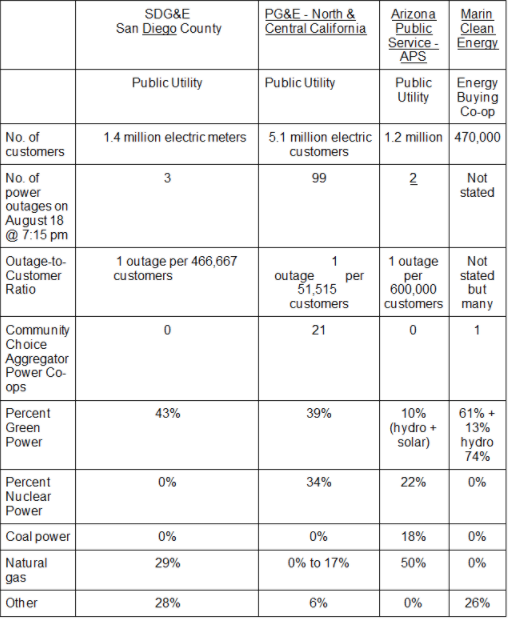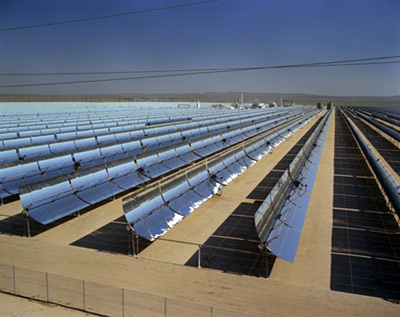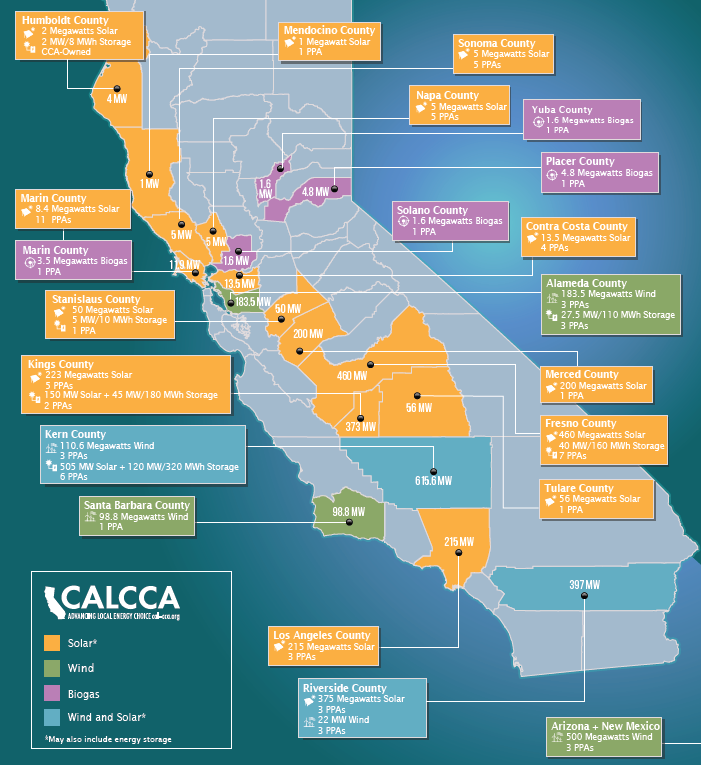
"Green" energy. (Photo: universityofcalifornia.edu)
CA Power Co-ops Respond to California Globe on Blackouts
The CCA says cause of blackouts unknown and CCA’s are not co-ops
By Wayne Lusvardi, August 24, 2020 12:48 pm
In response to the August 18 California Globe article, “Too Much Green Power Worsening Blackouts: Green Power-Buying Cooperatives are Worsening Problem,” Leora Broydo Vestel, Director of Communications for the California Community Choice Association, an organization of 21 green energy purchasing cooperatives, contacted the California Globe requesting six changes in the article. She emailed her concerns.
California Globe contributor Wayne Lusvardi, the author of the article, contacted two other energy experts for their professional analyses of his original article, and to address the CCA’s concerns.
Here they are:
Lusvardi wrote CCAs are “cooperatives” or “co-ops.”
1) Leora Broydo Vestel, Director of Communications for the California Community Choice Association, said Community Choice Aggregators (CCAs) are not cooperatives or co-ops. CCAs are formed and operated by city and county governments. Sometimes they are formed and operated by a single community (Rancho Mirage, San Jose and Lancaster operate single-city CCAs, for example). They also can be formed by two or more cities/counties joining together to form a joint-powers authority (JPA) that operates a CCA to serve customers in those communities (examples of JPAs include Clean Power Alliance, Valley Clean Energy, and East Bay Community Energy). You can find some general explanations about the operational models of CCAs HERE.
Jim Phelps, power engineer at U.C. Berkeley and author of California Community Choice: A False Choice, responded: “Single community CCAs that are not formed as a Joint Powers Authority introduce added risk to the municipal jurisdiction and its general funds. Government Code section 6508.1 insulates JPA municipal jurisdictions with language that states the debts, liabilities, and obligations of the JPA shall not be the debts, liabilities, and obligations of the individual members. Single-entity CCAs are not “joint” agencies and do not fall under that protective umbrella. Thus, where a CCA JPA can shut down (bankruptcy, etc) and insulate individual members’ general funds from legal obligations and commitments (power purchase agreements), single-entity CCAs do not appear to have that protection.”
Wayne Lusvardi also responded: “The bureaucratic term ‘Community Choice Aggregator’ is unintelligible to the public. The term purchasing cooperative is more understandable and more accurate (e.g., it would be confusing to call police ‘crime dis-aggregators’). “
The CCA denies they are a purchasing cooperative but below state they procure power and can leverage the purchasing of power of a larger buying group.
2) Lusvardi said in his article: “The wave of power outages in California during the heat wave of 2020 are mostly in the PG&E power grid area where 21 local green energy-buying cooperatives (called Community Choice Aggregators) are buying green power and green jobs for their communities.”
Leora Broydo Vestel, CCA: “There are 21 CCAs serving customers in California. Just 12 CCAs are serving customers in PG&E’s territory, not 21. They are: CleanPowerSF, East Bay Community Energy, King City Community Power, MCE, Monterey Bay Community Power, Peninsula Clean Energy, Pioneer Community Energy, Redwood Coast Energy Authority, San Jose Clean Energy, Silicon Valley Clean Energy, Sonoma Clean Power, and Valley Clean Energy. This handout has the names and locations of the CCAs. CCAs do support the creation of green jobs, but they do not ‘buy’ green jobs.”
Jim Phelps replied to CCA: “False. CCAs sell themselves to municipal jurisdiction leadership as “creating jobs” in order to gain entry in jurisdiction (City Council approval required before CCA can commence switching jurisdiction’s businesses and residents into CCA). CCAs are buying their way into municipal jurisdictions by buying jobs. Ironically, Marin’s full-time job creation was predominantly at MCE staff. Tax subsidies and marketing are what we find when peeling back the layers of ‘job creation.’”
Wayne Lusvardi replied to CCA: “Here is the link to the California CCA map – https://pv-magazine-usa.com/2018/11/27/californias-community-has-chosen-2-gw-of-renewables/
“Here is the link to the PG&E grid service area – http://energymlmca.com/wp-content/uploads/2011/07/basic_map11.gif
“I count 21 CCA’s in the PG&E service area or power grid network.”
“I never said CCAs ‘buy green jobs.’ I stated that politicians use green jobs to get elected (“buy votes”) both by CCA jobs and CCA’s green energy contracts. When CCA’s buy, say, solar power over cheaper, all-clean nuclear power, they are shifting jobs from the more competitive market-centered energy sector (Republicanish) to the subsidized, monopoly green sector (Democratish). Energy jobs are politicized and the economy is mixed, but green power wants a socialized and monopoly power system not diversity.”
3. These co-ops buy power for 10 million customers in 170 cities and counties and their goal is 100 percent green power by the 2030s, Lusvardi wrote.
Leora Broydo Vestel replied: “CCAs do not have a collective goal for achieving 100 percent green power by the 2030s or a collective goal of a specific level of green power. CCAs, like all load-serving entities (LSEs) in California, must comply with the state’s clean energy statues. California does have a requirement under SB 100 that all LSEs – CCAs, Investor-owned utilities (IOUs), and publicly-owned utilities (POUs) – achieve 100 percent clean energy by 2045.”
Jim Phelps replied to CCA: “False. CCAs aggressively go after enrolling large electric loads into their premium priced 100% Green energy programs. For instance, MCE pursued Marin’s largest electric consumer, Marin Municipal Water District, and each of the municipal jurisdictions on MCE’s JPA’s board in the counties of Marin, Solano, Napa, and Contra Costa. MCE collects a premium for 100% Deep Green energy even though it merely reassigns, or reallocates, the same energy from its general portfolio to “Deep Green.” (All of Deep Green’s energy resources also are assigned to Light Green; Deep Green’s behind-the-scenes fossil-fired power is assigned to Light Green to make Deep Green look clean.) CCAs do push consumers into their ultra clean products — but it is simply an accounting scam where consumers pay extra for the exact same energy they would get if remaining as a ratepayer in the low-cost Light Green product.”
Wayne Lusvardi replied to CCA: “This response avoids addressing the crucial issue raised in my article of diversification of power sources and redundancy needed for emergencies. The ISO said on August 18 a natural gas power plant went offline as wind power fell and imported backup hydropower was not available. But the other side of the power coin is also how much unreliable green power did each CCA contract for going into the hot month of August?”
“Stephen Berberich, President of the Independent System Operator (Cal-ISO) is critical of CCA’s not complying with orders from the California Public Utilities Commission (CPUC) to buy more adequate power:
“The CPUC’s order for utilities and other “load-serving entities” such as community-choice aggregators to procure 3,300 megawatts of resource adequacy has so far been met with contracts to build battery systems to store solar power for injection into the grid in the evening.”
Tom Tanton, formerly policy advisor to the California Energy Commission, replied to CCA: “While the CCA’s have green energy targets/goals, I don’t think they are dramatically different (as a group) than what you see in IOU and POU. As the CCA commenter points out, that is mostly a manifestation of state law, not of the individual nor collective CCA. In other words, CCA may have accelerated the move to less diversity, but not by much. And in actuality, it’s not LESS diversity, just different. Remember not too long ago, we were +60% natural gas (albeit with different prime mover technology.)”
“In my view, Lusvardi’s piece comes across as bashing CCA, when it is the contest between different technology advocates that’s the issue. AND it’s just going to get worse as more and more end uses are forced to electrify (care to speculate about demand/supply what’ll happen if/when cars are all electric?) THAT lack of diversity scares me even more.”
“What we need to do is to get people to start looking at the structure/conduct and performance of the electric industry…something that was stated back in ’95-96 but got sidetracked into the ‘solution’ called ‘deregulation’ before Cities for Climate Protection was fully fleshed out.”
“Electrification of everything will imbalance the market just as God made little green apples. It is also opposite of diverse, regardless of how diverse the sources of electricity. And the incentives are all wrong. Ever hear of a CPUC staffer or member get fired/fined/sued for making a bad forecast?”
4) The power grid has been deregulated and decentralized to allow local communities to buy their own power, resulting in a lack of diverse enough power sources during hot weather, Lusvardi wrote.
Leora Broydo Vestel replied: “According to the California Public Utilities Commission (CPUC), CCAs procured the resources that were needed to meet forecasted demand for August. The causes of the supply deficiencies that led to the rotating outages are still under investigation. The CPUC issued the following statement this week:
“The electricity demand of the last few days is consistent with the level the agencies have for August and the utilities and community choice aggregators procured the resources that were required to meet the forecasts. The question we’re tackling is why certain resources were not available. The CPUC has already made rule changes and modifications to the forecasting to adjust for changes in imported electricity that largely go into effect in 2021. As the Governor has directed, we and our sister agencies need to investigate this thoroughly to understand the how and why of the supply deficiencies that began on Friday. The many factors must be assessed in their entirety.”
“You can get the statement, which appeared in several articles about the outages, directly from CPUC spokesperson Terrie Prosper: (415) 703-2160, tdp@cpuc.ca.gov”
Wayne Lusvardi replied to CCA: “I once worked for a government wholesale water agency and was part of that agency’s 2001 Energy Crisis Task Force. Redundancy and diversification of power sources is one of the prime policies of energy or water portfolio and infrastructure management. It is disappointing to not hear that CCA’s have diversification plans other than 50 to 100 percent green power which is bound to fail to handle emergencies. There no longer is much back-up power available from other states because they also have also shifted to solar power that creates a late-day power peak (called “net peak”) requiring use of their own natural gas and hydro power plants to replace solar power that fades out at 4 pm each day. CCA’s short-sighted focus on green power and battery storage for green jobs creates a structural deficiency in regional grid networks.”
“However, states like Arizona can use coal power at least for now. California refuses to do so in order to comply with Pres. Obama’s Clean Power Plan (CPP) that was replaced a month ago with Pres. Trump’s more flexible Affordable Clean Energy (ACE) rule. California has sued the Federal EPA over Trump’s ACE rule and refuses to use coal power even in an emergency.”
5) Power Outages Table reply by CCA:
- Marin Clean Energy (now MCE) is listed as an energy-buying co-op. It is a CCA.
- SDG&E and PG&E are investor-owned utilities, not public utilities
- There is one CCA in SDG&E’s service territory – Solana Energy Alliance – not 0
- There are 12 CCAs serving customers in PG&E’s territory, not 21 (see #2 above for the 12 CCAs in PG&E territory).
- There are 8 CCAs in Southern California Edison’s territory. They are Apple Valley Choice Energy, Clean Power Alliance, Desert Community Energy, Lancaster Choice Energy, Pico Rivera Innovative Municipal Energy, Rancho Mirage Energy Authority, San Jacinto Power and Western Community Energy.
- This handout has the names and locations of the CCAs: https://cal-cca.org/wp-content/uploads/2020/07/CCAs-Contact-Info-and-Location-Website-2020.pdf
Wayne Lusvardi replied to CCA: “See my reply to CCA Response No. 2. There are 21 CCA’s shown on the CCA Map in the PG&E grid area. 95% of the reported outages on August 18 were within that area. Outside where CCA’s are clustered there were minimal outages. This does not mean CCA’s caused the blackouts but made them more susceptible.”
6) Green Power Co-Ops Worsen the Problem: The institutional source of the blackout problem is the proliferation of community energy-buying cooperatives (called Community Choice Aggregators) in local areas instead of the monopoly utility companies like Pacific Gas and Electric (PG&S), So Cal Edison and San Diego Gas and Election (SDG&E) buying power for customers in their service areas. This is shown in the data above where Marin Clean Energy, a green power buying co-op for Marin County, depends on 74 percent green power, including hydropower. (Conversely, Arizona Public Service could sustain its customers with 18 percent dirty coal power), Lusvardi wrote.
Leora Broydo Vestel replied: “According to the CPUC, CCAs procured the resources that were needed to meet demand forecasts for August. The causes of the supply deficiencies are still under investigation. The CPUC issued the following statement:
“The electricity demand of the last few days is consistent with the level the agencies have for August and the utilities and community choice aggregators procured the resources that were required to meet the forecasts. The question we’re tackling is why certain resources were not available. The CPUC has already made rule changes and modifications to the forecasting to adjust for changes in imported electricity that largely go into effect in 2021. As the Governor has directed, we and our sister agencies need to investigate this thoroughly to understand the how and why of the supply deficiencies that began on Friday. The many factors must be assessed in their entirety.”
Wayne Lusvardi replied to CCA: “The CCA response seems to be that the green power cup is half full but imported hydropower and a natural gas plant were half empty as the cause of the first blackouts in 19 years. But isn’t it both? If the CCA’s had bought more backup natural gas or coal-fired power would the blackouts have happened?. See “California Has First Rolling Blackouts in 19 Years – and Everyone Faces Blame”, Politico, August 18, 2020.”
You can get the statement, which appeared in several articles about the outages, directly from CPUC spokesperson Terrie Prosper: (415) 703-2160, tdp@cpuc.ca.gov
California Globe response team:
Tom Tanton, formerly policy advisor to the California Energy Commission
Jim Phelps, power engineer, U.C. Berkeley and author of California Community Choice: A False Choice, Marin, California
Wayne Lusvardi, formerly on the 2001 Energy Crisis Task Force for California’s largest urban water agency and freelance writer on water and energy at California Globe and MasterResource.org. Wayne appraises regulated water utilities.
- Peter Gleick’s National Water Plan for California - October 12, 2020
- Court Opens Up Big Prop.13 Loophole for ‘Public Franchise Fees’ - October 2, 2020
- New Cal Grid CEO is Ex-Enron Green Power Trader - September 29, 2020






Green Energy means it will cost you more Green
Utah kWh $0.10
My SoCal tier 1 rate $0.21
Things are always a “mystery” when the truth is inconvenient. When you don’t have enough reliable power generation you don’t have enough power. Mystery solved!